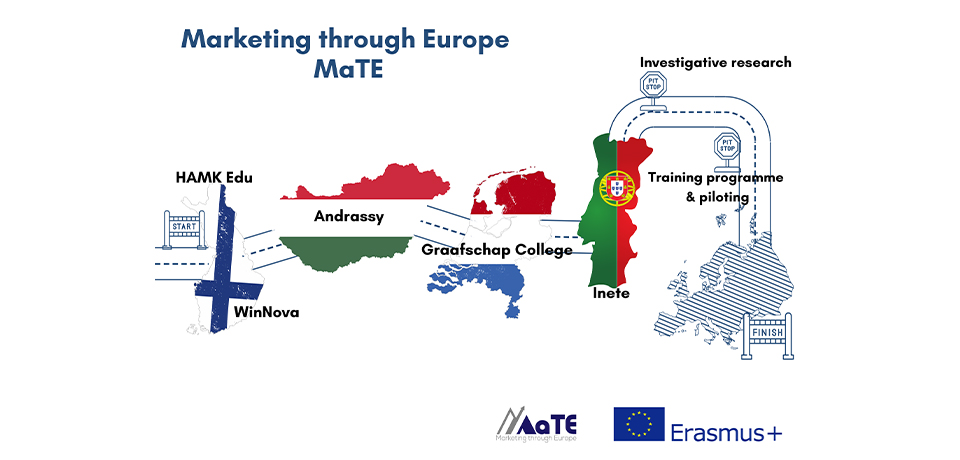
Heikki Hannula & Jonna Malmivuori
In formal education, students learn in different ways: they can follow lectures, do assignments, participate in simulations, etc. With extra resources, it is possible to try out alternative learning and teaching methods. In the Marketing Through Europe (MaTE) project, we had the possibility to develop marketing learning in an international context together with real companies. While students learned marketing skills in a way oriented towards working life, they also developed their soft skills, which are essential for internationalization and a smooth transition from school to work.
Marketing is an activity through which one promotes one’s product or services. In business, the goals are usually commercial and aim to sell products and/or services (Kotler & Armstrong, 2021, pp. 24–25). Among other goals, business education aims to develop students’ marketing skills. Competences are defined in more detail in the national vocational qualification standards and in educational institution-specific curricula. The comparison of these standards and curricula and the development of educational practices and teaching were among the goals of the MaTE project.
Marketing, like many other skills, is best learned in real environments and situations. Theoretical knowledge is needed, but it is also essential to put it into practice (Hannula, 2018). In the MaTE project, the aim was to share good practices between four European secondary-level business schools (namely Graafschap College in the Netherlands, INETE in Portugal, Andrassy College in Hungary, and WinNova in Finland) and develop them further. One output of the project was a pedagogical model that can be called the “MaTE model.”
In this article, we analyze the MaTE model and its pedagogical premises. We will not go through all the details and deviations of the implementation but instead focus on describing the basics of the model as if it had been realized completely as planned. However, it needs to be specified that there were no major deviations in the project regarding the functionality of the model.
In the project, the model was piloted twice. The role of the participating companies was different in the two pilots. The number of participants was the same both times. Students, as well as companies, changed between implementations. The participating and coaching teachers remained the same.
The MaTE model
In one pilot, sixteen students, four teachers, and four companies participated in the one-time implementation of the model. Of course, the model can be applied with different numbers of participants, but in terms of mathematics, the model is easier to implement with a similar ratio of students, teachers and companies.
The process starts by selecting the students who will join it. Four students are selected from each school. The students participate in an initial survey that is used to assess their competences at baseline. An evaluation form provides information on both their so-called soft skills and marketing skills. National student groups learn about the marketing of one partner company in each of the involved countries (in our case, the Netherlands, Portugal, Hungary, and Finland). Data and information are acquired through a survey, participatory observation, and interviews. The groups prepare a presentation of the results for the beginning of a mobility week. Preparation work takes place in each participating country in the national student groups, but the documents are distributed to all the participants in an open digital space, for example, using Microsoft Teams. All the students and teachers meet each other virtually via a remote connection before the mobility week takes place.
The students meet each other face to face during the mobility week. In practice, one participating educational institution invites the others as its guests. The host college invites four volunteer companies to join the process. These companies are ready to offer the four multinational student groups the opportunity to prepare a plan for the company’s marketing development and make suggestions for actual marketing activities. On the first day of the week, the partner company guides the student groups in question through the basics of the company and its operating environment. The company also informs the students about its expectations regarding the marketing plan and activities.
On the second and third day of the week, the students prepare marketing plans and activities. They acquire information through both field and desk research. A representative of the company will provide additional information if necessary. Similarly, the students are able to speak to the teachers and the teachers guide the groups, based on a mutual division of labor.
On the fourth day, in the forenoon the students finalize their plans and prepare to present them publicly at a joint presentation event in the afternoon. The companies give feedback on the plans and make them available for possible use. After the presentations, each teacher guides one multinational student group through reflecting on the marketing competences and soft skills learned during the process.
On the fifth day, which is the final day of the program, the students have a culture-focused day. Students from the host country guide the visiting students through cultural experiences in the surrounding area. During the day, the students also evaluate the business skills and soft skills that they have learned using the same survey form that they filled in when the process started. The data gathered using the forms is analyzed, and the differences between the two responses are evaluated.
About a week after the mobility week, the students and teachers meet online. The feedback given by the companies and the results of the competence surveys are discussed.
Reflection
The development of the model started by implementing a survey aimed at company representatives. We wanted to find out what kind of skills working life expects from a person with a secondary degree in marketing. The results were not surprising. Employers expect good marketing skills, such as being able to perform operational environment analyses, find out customer needs, and having product knowledge. Employers also value soft, generic skills, such as teamwork, problem-solving skills, and flexibility (Hannula & Lindroos, 2022). In the MaTE model, we wished to emphasize the students learning both marketing and soft skills. We also wanted to investigate the development of soft skills by implementing the survey for students at the beginning and end of the process. In conclusion we can say that the MaTE model worked well regarding the self-evaluated development of the students’ soft skills and worked as a framework for acquiring information on the students’ development.
The model implements the idea of cooperative learning (Clarke, 2002, p. 83). Students first work in national home groups, then switch to multinational expert groups, and finally return to home groups in order to reflect. Learning in an authentic learning environment in cooperation with real companies is applied in the MaTE model. Students get the opportunity to learn by looking for solutions to real problems in working life (Ryymin et al., 2020). They get feedback from company representatives and teachers. Peer review is also used as an assessment method. During the implementation of the MaTE model, the students and teachers involved get valuable experience of European business and get a glimpse of the marketing environment of another European country. Besides this, the teachers also develop their understanding of the similarities and differences of VET education in European countries.
As a final summary, we can state that at least team learning, cooperative learning, working life-oriented learning, learning together with the representatives of companies, an international learning environment, and sustainability are present in the MaTE model. It would be great if such learning experiences could be offered to more and more vocational students and teachers — why not to all?
Authors
Heikki Hannula, Ph. D., M. Sc., is a lecturer at Häme University of Applied Sciences. He has worked as a professional teacher trainer at HAMK since 2002. He has been involved in several national and international development projects in teacher education and entrepreneurship education.
Jonna Malmivuori, M. Sc. (Econ.), works as a development specialist at Länsirannikon Koulutus Oy WinNova. She has been working in development since 2011 and has been responsible for several national and international development projects. Prior to that, Jonna worked as a vocational teacher and vocational guidance counsellor in the business field in adult education. In the MaTE project, she has worked as a project manager.
References
Clarke, J. (2002). Palapeli. In Sahlberg, P., & Sharan, S. (2002). Yhteistoiminnallisen oppimisen käsikirja. WSOY, pp. 83–100.
Hannula, H. (2018). Yrittäjyyskasvatusta siirtymää tukevissa oppimisympäristöissä. HAMK Unlimited Journal, 9.1.2018. https://urn.fi/URN:NBN:fi-fe2020111790833
Hannula, H., & Lindroos, H. (2021). Marketing Related Competences – Investigative Research in four European Countries. HAMK Unlimited Professional,28.10.2021. https://urn.fi/URN:NBN:fi-fe2021112557069
Kotler, P., Armstrong, G., & Opresnik, M. O. (2021). Principles of Marketing (Eighteenth edition, Global edition). Pearson.
Ryymin, E., Postareff, L., & Rintala, H. (2020). Uutta tutkimusta jatkuvasta oppimisesta työssä. HAMK Unlimited Professional, 17.4.2020. https://urn.fi/URN:NBN:fi-fe2020041718994





